Marketing Design Innovation : Assignment
VerifiedAdded on 2021/01/02
|20
|6283
|182
AI Summary
Contribute Materials
Your contribution can guide someone’s learning journey. Share your
documents today.
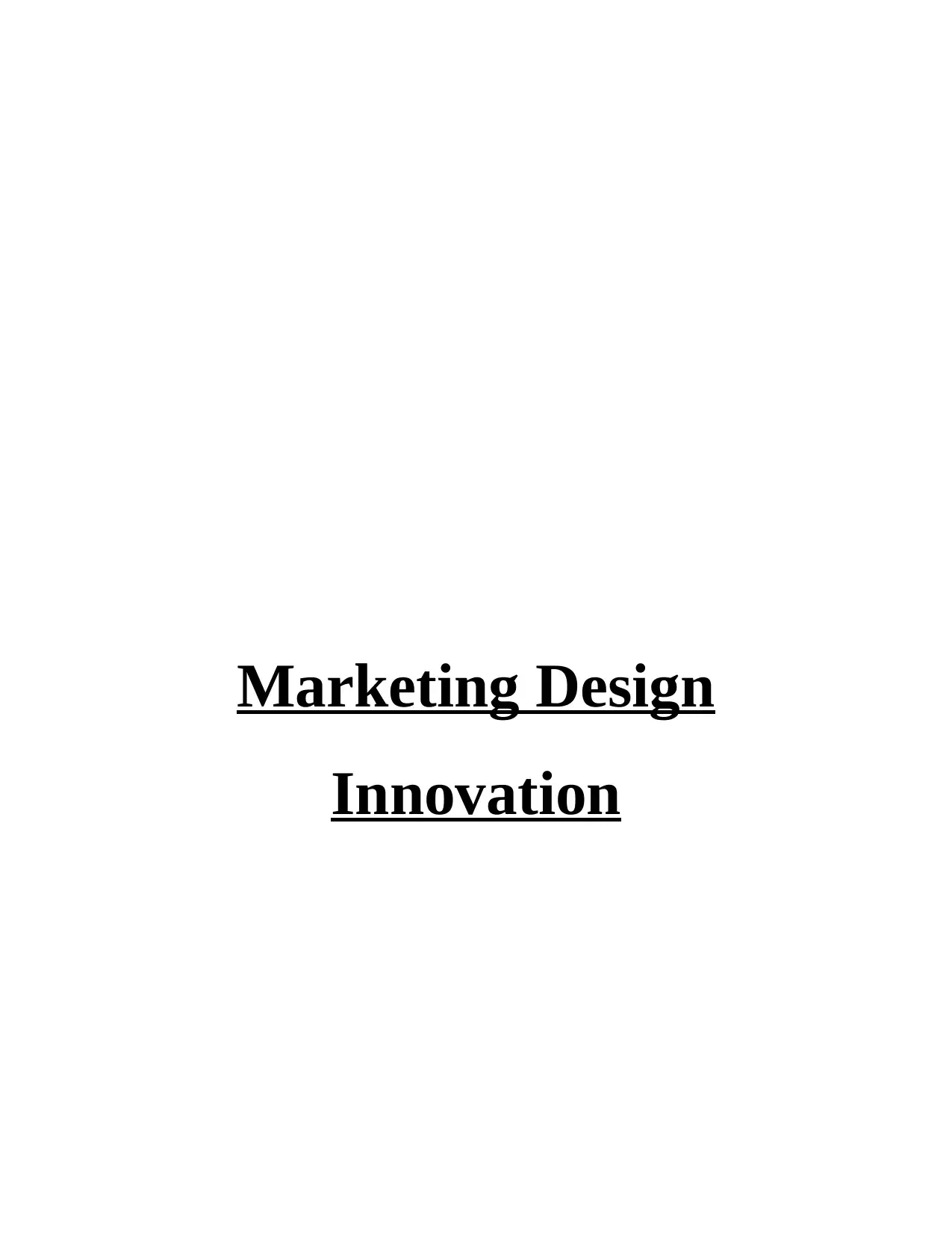
Marketing Design
Innovation
Innovation
Secure Best Marks with AI Grader
Need help grading? Try our AI Grader for instant feedback on your assignments.
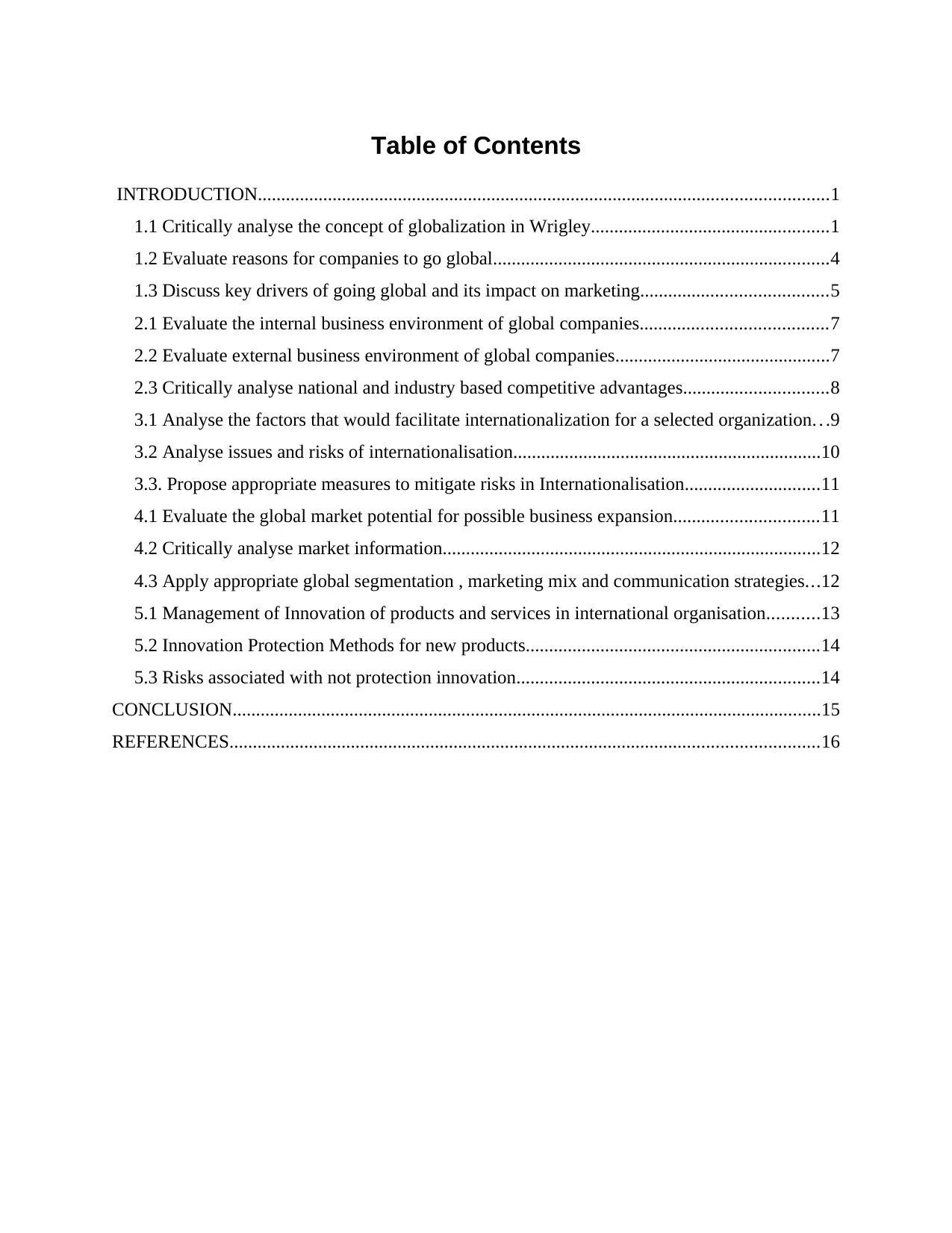
Table of Contents
INTRODUCTION..........................................................................................................................1
1.1 Critically analyse the concept of globalization in Wrigley...................................................1
1.2 Evaluate reasons for companies to go global........................................................................4
1.3 Discuss key drivers of going global and its impact on marketing........................................5
2.1 Evaluate the internal business environment of global companies........................................7
2.2 Evaluate external business environment of global companies..............................................7
2.3 Critically analyse national and industry based competitive advantages...............................8
3.1 Analyse the factors that would facilitate internationalization for a selected organization. . .9
3.2 Analyse issues and risks of internationalisation..................................................................10
3.3. Propose appropriate measures to mitigate risks in Internationalisation.............................11
4.1 Evaluate the global market potential for possible business expansion...............................11
4.2 Critically analyse market information.................................................................................12
4.3 Apply appropriate global segmentation , marketing mix and communication strategies...12
5.1 Management of Innovation of products and services in international organisation...........13
5.2 Innovation Protection Methods for new products...............................................................14
5.3 Risks associated with not protection innovation.................................................................14
CONCLUSION..............................................................................................................................15
REFERENCES..............................................................................................................................16
INTRODUCTION..........................................................................................................................1
1.1 Critically analyse the concept of globalization in Wrigley...................................................1
1.2 Evaluate reasons for companies to go global........................................................................4
1.3 Discuss key drivers of going global and its impact on marketing........................................5
2.1 Evaluate the internal business environment of global companies........................................7
2.2 Evaluate external business environment of global companies..............................................7
2.3 Critically analyse national and industry based competitive advantages...............................8
3.1 Analyse the factors that would facilitate internationalization for a selected organization. . .9
3.2 Analyse issues and risks of internationalisation..................................................................10
3.3. Propose appropriate measures to mitigate risks in Internationalisation.............................11
4.1 Evaluate the global market potential for possible business expansion...............................11
4.2 Critically analyse market information.................................................................................12
4.3 Apply appropriate global segmentation , marketing mix and communication strategies...12
5.1 Management of Innovation of products and services in international organisation...........13
5.2 Innovation Protection Methods for new products...............................................................14
5.3 Risks associated with not protection innovation.................................................................14
CONCLUSION..............................................................................................................................15
REFERENCES..............................................................................................................................16

INTRODUCTION
Innovation refers to a process of transforming an idea or invention into a product or
service which create value that customers pay. This can be achieved more effectively by use of
technologies, services, ideas or processes that are easily available to market. Market design plays
a key role in promoting innovations. It basically determines certain rules under which market
participants communicate. The selected organisation is Wrigley company, which deals in
chewing gum.
The aim of this report is to explain the prevailing competition in the market and concept
of globalization and key drivers of going global and its impact on marketing. Innovation
marketing as a discipline encompasses marketing activities in the innovation process. The report
will evaluate internal and external business environment of global companies. The chosen
organisation for the report is Wrigley. Wrigley is an American Chewing Gum company which is
founded in 1891. The company produces chewing gums for a variety of consume groups
including children, adults etc. The chosen product for the company is Orbit Drops. Orbit Drops
were launched in 2003 in Austria.
It is one of the Top selling brands of chewing gum. Also, the report will explain the
competitive advantage that exist when the firm is able to deliver the same benefits as rivals but
as a lower cost or provide benefits that exceed those competing commodities. Further it will
analyse national and industry based competitive, advantages, factors that would facilitate
internationalization for a selected organization and issues and risks of internationalisation.
Moreover, it will cover management of innovation of products and services in international
organisation and evaluate the risks associated with not protecting innovation.
1.1 Critically analyse the concept of globalization in Wrigley
The process of integration between people, companies and government on worldwide
level is known as globalisation. Expansion in global market has helped to foster efficiency
through competition & the division of labour. The concept of globalisation refers to process of
increase of social, cultural and political relations across international boundaries. It can also
create a framework cooperation among nations on a range of non-economic issues that have
cross border implications (Allal, Mansouri and Qbadou, 2018). According to the influence on the
integration between countries on both the national and international society, it can be described
1
Innovation refers to a process of transforming an idea or invention into a product or
service which create value that customers pay. This can be achieved more effectively by use of
technologies, services, ideas or processes that are easily available to market. Market design plays
a key role in promoting innovations. It basically determines certain rules under which market
participants communicate. The selected organisation is Wrigley company, which deals in
chewing gum.
The aim of this report is to explain the prevailing competition in the market and concept
of globalization and key drivers of going global and its impact on marketing. Innovation
marketing as a discipline encompasses marketing activities in the innovation process. The report
will evaluate internal and external business environment of global companies. The chosen
organisation for the report is Wrigley. Wrigley is an American Chewing Gum company which is
founded in 1891. The company produces chewing gums for a variety of consume groups
including children, adults etc. The chosen product for the company is Orbit Drops. Orbit Drops
were launched in 2003 in Austria.
It is one of the Top selling brands of chewing gum. Also, the report will explain the
competitive advantage that exist when the firm is able to deliver the same benefits as rivals but
as a lower cost or provide benefits that exceed those competing commodities. Further it will
analyse national and industry based competitive, advantages, factors that would facilitate
internationalization for a selected organization and issues and risks of internationalisation.
Moreover, it will cover management of innovation of products and services in international
organisation and evaluate the risks associated with not protecting innovation.
1.1 Critically analyse the concept of globalization in Wrigley
The process of integration between people, companies and government on worldwide
level is known as globalisation. Expansion in global market has helped to foster efficiency
through competition & the division of labour. The concept of globalisation refers to process of
increase of social, cultural and political relations across international boundaries. It can also
create a framework cooperation among nations on a range of non-economic issues that have
cross border implications (Allal, Mansouri and Qbadou, 2018). According to the influence on the
integration between countries on both the national and international society, it can be described
1

as a complex entity. Consumers that are present globally make purchasing decisions to acquire
the best quality goods at the most affordable price. Due to the emergence of internet, they have
all information regarding company's goods. Hence, Innovation takes centre stage to obtain
adequate attention from potential customers, for this various companies uses 4P's of innovation
i.e. Product, Process, Position and Paradigm. Apart from this, the three key approaches of
Porter's Generic strategies that are; cost leadership, differentiation and focus strategy also allow
company to attain competitive advantage globally.
It is structurally advanced by certain driving forces, called main drivers. There are three main
types of globalisation: Political: Refers to the number of political co-operation that exist between different
countries. Social: Refers to the sharing of information & ideas between and through different
countries.
Economic: Refers to the interconnectedness of economies through trade and exchange of
resources.
Globalisation as transference, implies exchange across borders & among units. It affects
the interests and intentions of specific countries. It needs accountability, and financial
transparency in to inform about public policies.
Consumer Trends
Below mentioned are the consumer trends in context of orbit drops of Wrigley:
Awareness of more flavours: Consumers today are more aware about different flavours. The
company needs to put more focus on global flavours which can increase its efficiency in selling
of Orbit Drops. Flavours can include chocolate, blueberry, cherry drops etc. Introducing these
flavours can ensure growth of the brand and products.
Health Issues: People are more interested in healthy gums which does not jeopardise their health
and ensure their good health. Keeping in mind the healthy products the company can produce
such products which are healthy and good for the healthy of the consumers.
2
the best quality goods at the most affordable price. Due to the emergence of internet, they have
all information regarding company's goods. Hence, Innovation takes centre stage to obtain
adequate attention from potential customers, for this various companies uses 4P's of innovation
i.e. Product, Process, Position and Paradigm. Apart from this, the three key approaches of
Porter's Generic strategies that are; cost leadership, differentiation and focus strategy also allow
company to attain competitive advantage globally.
It is structurally advanced by certain driving forces, called main drivers. There are three main
types of globalisation: Political: Refers to the number of political co-operation that exist between different
countries. Social: Refers to the sharing of information & ideas between and through different
countries.
Economic: Refers to the interconnectedness of economies through trade and exchange of
resources.
Globalisation as transference, implies exchange across borders & among units. It affects
the interests and intentions of specific countries. It needs accountability, and financial
transparency in to inform about public policies.
Consumer Trends
Below mentioned are the consumer trends in context of orbit drops of Wrigley:
Awareness of more flavours: Consumers today are more aware about different flavours. The
company needs to put more focus on global flavours which can increase its efficiency in selling
of Orbit Drops. Flavours can include chocolate, blueberry, cherry drops etc. Introducing these
flavours can ensure growth of the brand and products.
Health Issues: People are more interested in healthy gums which does not jeopardise their health
and ensure their good health. Keeping in mind the healthy products the company can produce
such products which are healthy and good for the healthy of the consumers.
2
Paraphrase This Document
Need a fresh take? Get an instant paraphrase of this document with our AI Paraphraser

Sustainability: In today's world sustainability is one of the major concerns. People today buy
products which are made in a sustainability and a healthy environment. Wrigley should maintain
better sustainability within the company and its environment. It can produce better products with
the help of sustainable products.
The above consumer trends can make sure good and better production of product which
can lead towards company's growth and advantage.
Maslow Hierarchy of needs theory
Below mentioned as in what ways Maslow Hierarchy of needs is used by Wrigley in
launch of Orbit.
Self-actualization: The self-actualization needs of its consumers were understood at first
and these needs were fulfilled in order to achieve better consumer understandings.
Esteem: The needs to esteem were identified where consumers esteem needs such as
their goals, needs and developments were understood.
Love/Belonging: The love and belonging needs allowed Wrigley to understand at what
places the consumers emotional needs can be targeted in selling of its new products.
Safety: The safety needs of the consumers ensured that in what ways the products needs
to made so that the safety of the consumers does not gets compromised. For example: Production
of healthy chewing gums.
Physiological: At last, the physiological needs to the consumers were identified to
understand the demands of the products in the new market. It ensured that the products made
needs to be made as per the consumer physiological needs and their brief identifications.
3
products which are made in a sustainability and a healthy environment. Wrigley should maintain
better sustainability within the company and its environment. It can produce better products with
the help of sustainable products.
The above consumer trends can make sure good and better production of product which
can lead towards company's growth and advantage.
Maslow Hierarchy of needs theory
Below mentioned as in what ways Maslow Hierarchy of needs is used by Wrigley in
launch of Orbit.
Self-actualization: The self-actualization needs of its consumers were understood at first
and these needs were fulfilled in order to achieve better consumer understandings.
Esteem: The needs to esteem were identified where consumers esteem needs such as
their goals, needs and developments were understood.
Love/Belonging: The love and belonging needs allowed Wrigley to understand at what
places the consumers emotional needs can be targeted in selling of its new products.
Safety: The safety needs of the consumers ensured that in what ways the products needs
to made so that the safety of the consumers does not gets compromised. For example: Production
of healthy chewing gums.
Physiological: At last, the physiological needs to the consumers were identified to
understand the demands of the products in the new market. It ensured that the products made
needs to be made as per the consumer physiological needs and their brief identifications.
3
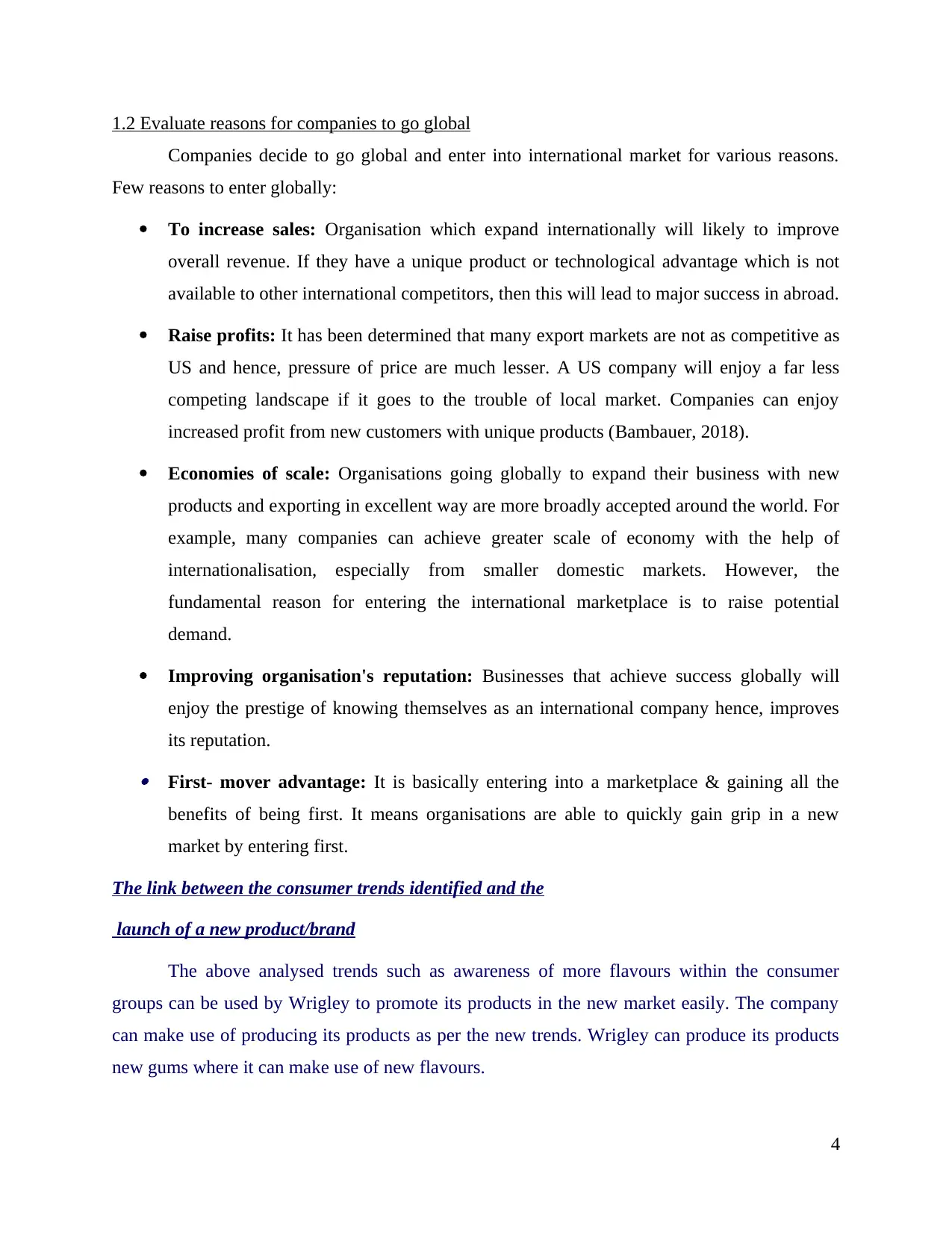
1.2 Evaluate reasons for companies to go global
Companies decide to go global and enter into international market for various reasons.
Few reasons to enter globally:
To increase sales: Organisation which expand internationally will likely to improve
overall revenue. If they have a unique product or technological advantage which is not
available to other international competitors, then this will lead to major success in abroad.
Raise profits: It has been determined that many export markets are not as competitive as
US and hence, pressure of price are much lesser. A US company will enjoy a far less
competing landscape if it goes to the trouble of local market. Companies can enjoy
increased profit from new customers with unique products (Bambauer, 2018).
Economies of scale: Organisations going globally to expand their business with new
products and exporting in excellent way are more broadly accepted around the world. For
example, many companies can achieve greater scale of economy with the help of
internationalisation, especially from smaller domestic markets. However, the
fundamental reason for entering the international marketplace is to raise potential
demand.
Improving organisation's reputation: Businesses that achieve success globally will
enjoy the prestige of knowing themselves as an international company hence, improves
its reputation. First- mover advantage: It is basically entering into a marketplace & gaining all the
benefits of being first. It means organisations are able to quickly gain grip in a new
market by entering first.
The link between the consumer trends identified and the
launch of a new product/brand
The above analysed trends such as awareness of more flavours within the consumer
groups can be used by Wrigley to promote its products in the new market easily. The company
can make use of producing its products as per the new trends. Wrigley can produce its products
new gums where it can make use of new flavours.
4
Companies decide to go global and enter into international market for various reasons.
Few reasons to enter globally:
To increase sales: Organisation which expand internationally will likely to improve
overall revenue. If they have a unique product or technological advantage which is not
available to other international competitors, then this will lead to major success in abroad.
Raise profits: It has been determined that many export markets are not as competitive as
US and hence, pressure of price are much lesser. A US company will enjoy a far less
competing landscape if it goes to the trouble of local market. Companies can enjoy
increased profit from new customers with unique products (Bambauer, 2018).
Economies of scale: Organisations going globally to expand their business with new
products and exporting in excellent way are more broadly accepted around the world. For
example, many companies can achieve greater scale of economy with the help of
internationalisation, especially from smaller domestic markets. However, the
fundamental reason for entering the international marketplace is to raise potential
demand.
Improving organisation's reputation: Businesses that achieve success globally will
enjoy the prestige of knowing themselves as an international company hence, improves
its reputation. First- mover advantage: It is basically entering into a marketplace & gaining all the
benefits of being first. It means organisations are able to quickly gain grip in a new
market by entering first.
The link between the consumer trends identified and the
launch of a new product/brand
The above analysed trends such as awareness of more flavours within the consumer
groups can be used by Wrigley to promote its products in the new market easily. The company
can make use of producing its products as per the new trends. Wrigley can produce its products
new gums where it can make use of new flavours.
4

These products can make the company produce its products are per the consumer trends
and achieve desired set of goals and objectives. The Orbits Drop are more flavoured as per the
consumers flavour needs.
The next trends is the health issues of the consumers. Wrigley should produce its
products are per the consumer health wants. This can make the company produce its products
with keeping in mind the health of its consumers.
Also, sustainability can make its company produce its products are per the better
environment rules and regulations. It can make the company achieve a good place in company
products and services and achieve a sustainable products and services, along with selling them
accordingly.
1.3 Discuss key drivers of going global and its impact on marketing
A driver is determined as the contributing factor of change (Baylis, Smith and Owens,
2017). The main drivers of going internationally include technological, political, market, cost,
and competitive drivers:
Technological advancement: The technological driver has given shape & set foundation
for modern globalisation. The industry has been changed due to innovations in the
transportation technology. Recent growth of internet is the latest technological driver
that made global e-commerce. Wrigley has been able to manage, reproduce & standardise
their product across the world with the help of local sources of ingredients.
Market drivers: As domestic markets are becoming more and more concentrated, the
growth opportunities are getting limited & for this, many organisations go for global
expanding as it is the only way to overcome this situation. Existing customer's needs, the
chance to use international market channels and transfer market to some extent are also
incentives to choose international marketplace.
Cost drivers: costs vary from countries to countries and it has been determined that
global firms can take advantage of this. Furthermore, an opportunity to create global
scale economies & the high product development costs are classified as other cost
drivers.
Impact on organisations
5
and achieve desired set of goals and objectives. The Orbits Drop are more flavoured as per the
consumers flavour needs.
The next trends is the health issues of the consumers. Wrigley should produce its
products are per the consumer health wants. This can make the company produce its products
with keeping in mind the health of its consumers.
Also, sustainability can make its company produce its products are per the better
environment rules and regulations. It can make the company achieve a good place in company
products and services and achieve a sustainable products and services, along with selling them
accordingly.
1.3 Discuss key drivers of going global and its impact on marketing
A driver is determined as the contributing factor of change (Baylis, Smith and Owens,
2017). The main drivers of going internationally include technological, political, market, cost,
and competitive drivers:
Technological advancement: The technological driver has given shape & set foundation
for modern globalisation. The industry has been changed due to innovations in the
transportation technology. Recent growth of internet is the latest technological driver
that made global e-commerce. Wrigley has been able to manage, reproduce & standardise
their product across the world with the help of local sources of ingredients.
Market drivers: As domestic markets are becoming more and more concentrated, the
growth opportunities are getting limited & for this, many organisations go for global
expanding as it is the only way to overcome this situation. Existing customer's needs, the
chance to use international market channels and transfer market to some extent are also
incentives to choose international marketplace.
Cost drivers: costs vary from countries to countries and it has been determined that
global firms can take advantage of this. Furthermore, an opportunity to create global
scale economies & the high product development costs are classified as other cost
drivers.
Impact on organisations
5
Secure Best Marks with AI Grader
Need help grading? Try our AI Grader for instant feedback on your assignments.
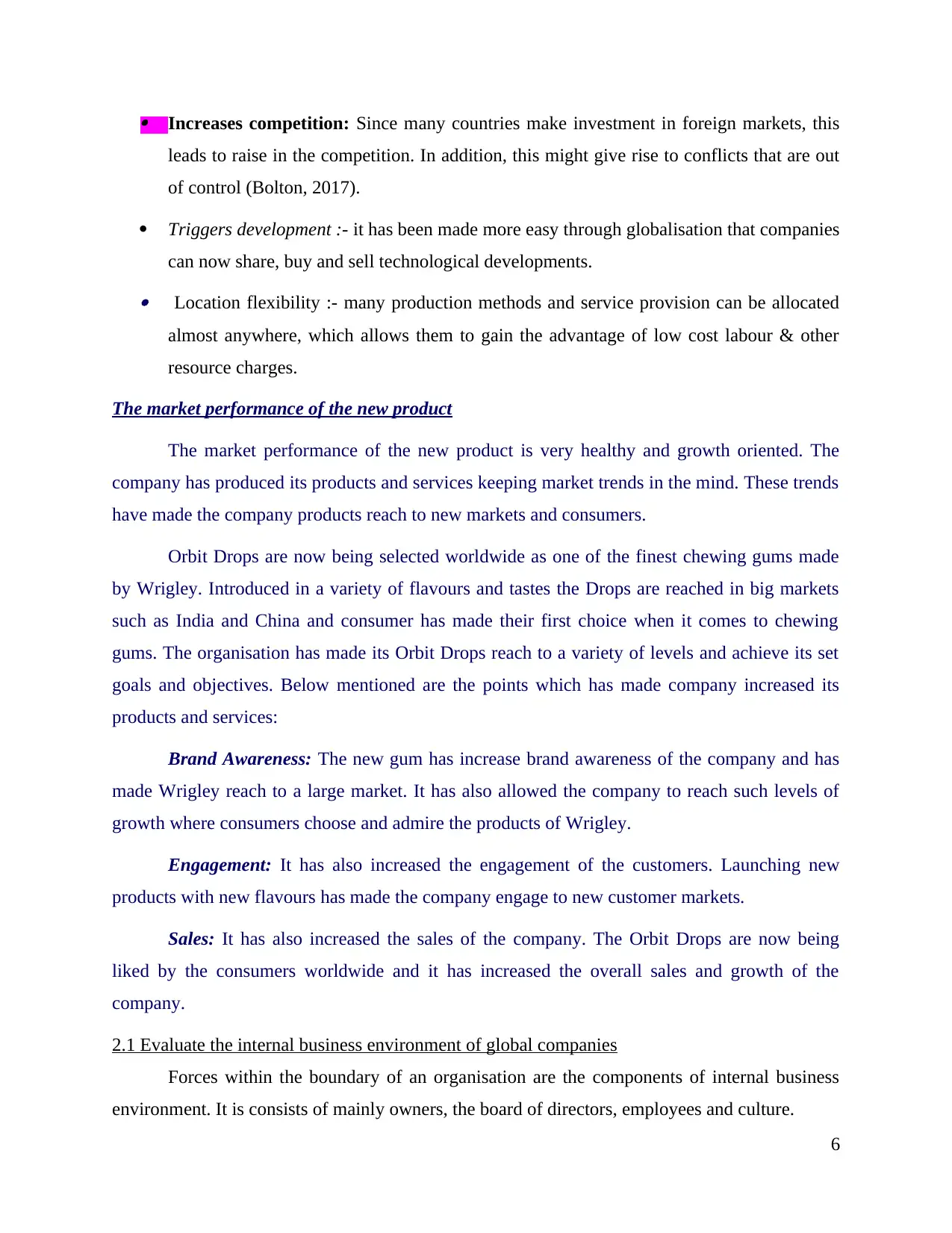
Increases competition: Since many countries make investment in foreign markets, this
leads to raise in the competition. In addition, this might give rise to conflicts that are out
of control (Bolton, 2017).
Triggers development :- it has been made more easy through globalisation that companies
can now share, buy and sell technological developments. Location flexibility :- many production methods and service provision can be allocated
almost anywhere, which allows them to gain the advantage of low cost labour & other
resource charges.
The market performance of the new product
The market performance of the new product is very healthy and growth oriented. The
company has produced its products and services keeping market trends in the mind. These trends
have made the company products reach to new markets and consumers.
Orbit Drops are now being selected worldwide as one of the finest chewing gums made
by Wrigley. Introduced in a variety of flavours and tastes the Drops are reached in big markets
such as India and China and consumer has made their first choice when it comes to chewing
gums. The organisation has made its Orbit Drops reach to a variety of levels and achieve its set
goals and objectives. Below mentioned are the points which has made company increased its
products and services:
Brand Awareness: The new gum has increase brand awareness of the company and has
made Wrigley reach to a large market. It has also allowed the company to reach such levels of
growth where consumers choose and admire the products of Wrigley.
Engagement: It has also increased the engagement of the customers. Launching new
products with new flavours has made the company engage to new customer markets.
Sales: It has also increased the sales of the company. The Orbit Drops are now being
liked by the consumers worldwide and it has increased the overall sales and growth of the
company.
2.1 Evaluate the internal business environment of global companies
Forces within the boundary of an organisation are the components of internal business
environment. It is consists of mainly owners, the board of directors, employees and culture.
6
leads to raise in the competition. In addition, this might give rise to conflicts that are out
of control (Bolton, 2017).
Triggers development :- it has been made more easy through globalisation that companies
can now share, buy and sell technological developments. Location flexibility :- many production methods and service provision can be allocated
almost anywhere, which allows them to gain the advantage of low cost labour & other
resource charges.
The market performance of the new product
The market performance of the new product is very healthy and growth oriented. The
company has produced its products and services keeping market trends in the mind. These trends
have made the company products reach to new markets and consumers.
Orbit Drops are now being selected worldwide as one of the finest chewing gums made
by Wrigley. Introduced in a variety of flavours and tastes the Drops are reached in big markets
such as India and China and consumer has made their first choice when it comes to chewing
gums. The organisation has made its Orbit Drops reach to a variety of levels and achieve its set
goals and objectives. Below mentioned are the points which has made company increased its
products and services:
Brand Awareness: The new gum has increase brand awareness of the company and has
made Wrigley reach to a large market. It has also allowed the company to reach such levels of
growth where consumers choose and admire the products of Wrigley.
Engagement: It has also increased the engagement of the customers. Launching new
products with new flavours has made the company engage to new customer markets.
Sales: It has also increased the sales of the company. The Orbit Drops are now being
liked by the consumers worldwide and it has increased the overall sales and growth of the
company.
2.1 Evaluate the internal business environment of global companies
Forces within the boundary of an organisation are the components of internal business
environment. It is consists of mainly owners, the board of directors, employees and culture.
6
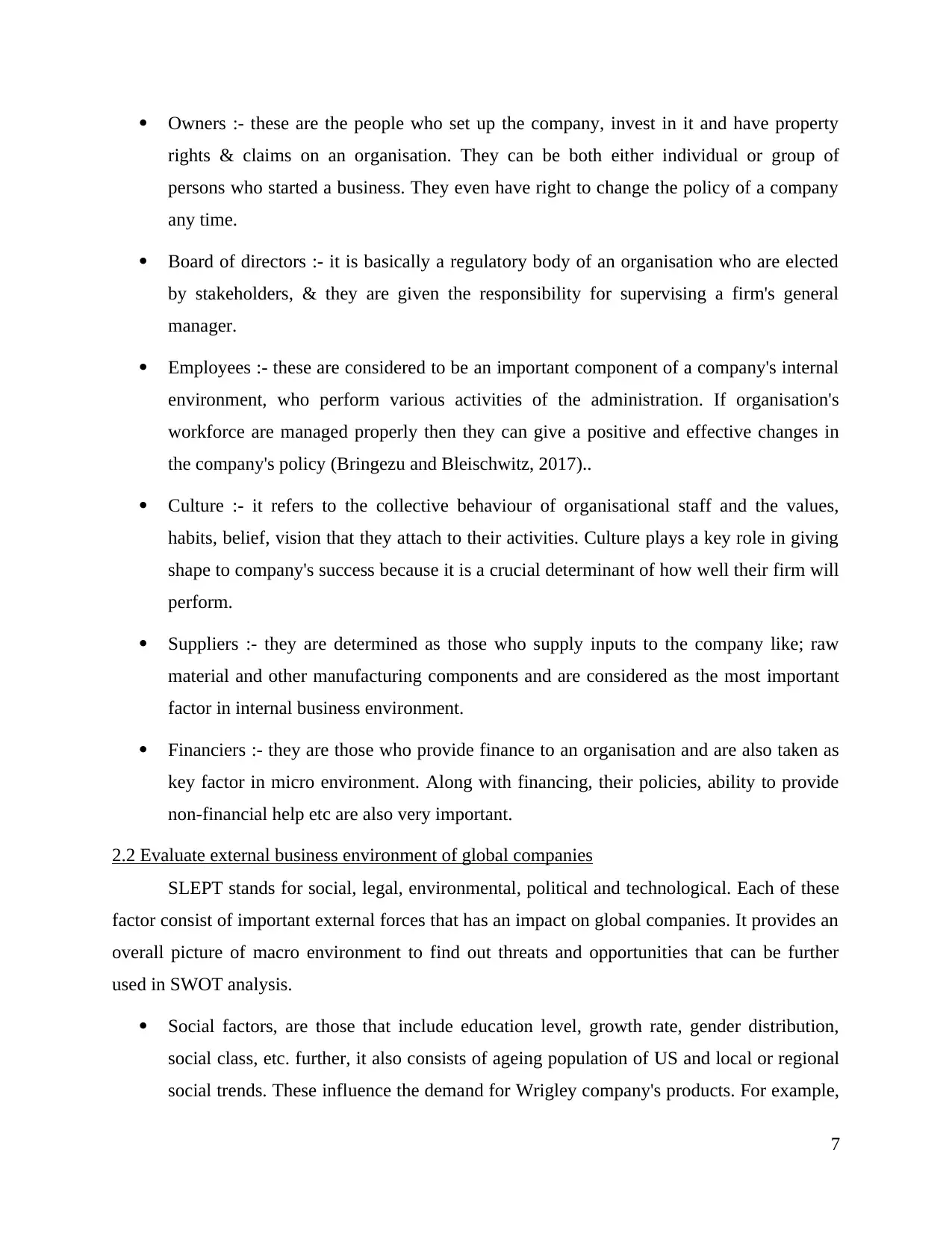
Owners :- these are the people who set up the company, invest in it and have property
rights & claims on an organisation. They can be both either individual or group of
persons who started a business. They even have right to change the policy of a company
any time.
Board of directors :- it is basically a regulatory body of an organisation who are elected
by stakeholders, & they are given the responsibility for supervising a firm's general
manager.
Employees :- these are considered to be an important component of a company's internal
environment, who perform various activities of the administration. If organisation's
workforce are managed properly then they can give a positive and effective changes in
the company's policy (Bringezu and Bleischwitz, 2017)..
Culture :- it refers to the collective behaviour of organisational staff and the values,
habits, belief, vision that they attach to their activities. Culture plays a key role in giving
shape to company's success because it is a crucial determinant of how well their firm will
perform.
Suppliers :- they are determined as those who supply inputs to the company like; raw
material and other manufacturing components and are considered as the most important
factor in internal business environment.
Financiers :- they are those who provide finance to an organisation and are also taken as
key factor in micro environment. Along with financing, their policies, ability to provide
non-financial help etc are also very important.
2.2 Evaluate external business environment of global companies
SLEPT stands for social, legal, environmental, political and technological. Each of these
factor consist of important external forces that has an impact on global companies. It provides an
overall picture of macro environment to find out threats and opportunities that can be further
used in SWOT analysis.
Social factors, are those that include education level, growth rate, gender distribution,
social class, etc. further, it also consists of ageing population of US and local or regional
social trends. These influence the demand for Wrigley company's products. For example,
7
rights & claims on an organisation. They can be both either individual or group of
persons who started a business. They even have right to change the policy of a company
any time.
Board of directors :- it is basically a regulatory body of an organisation who are elected
by stakeholders, & they are given the responsibility for supervising a firm's general
manager.
Employees :- these are considered to be an important component of a company's internal
environment, who perform various activities of the administration. If organisation's
workforce are managed properly then they can give a positive and effective changes in
the company's policy (Bringezu and Bleischwitz, 2017)..
Culture :- it refers to the collective behaviour of organisational staff and the values,
habits, belief, vision that they attach to their activities. Culture plays a key role in giving
shape to company's success because it is a crucial determinant of how well their firm will
perform.
Suppliers :- they are determined as those who supply inputs to the company like; raw
material and other manufacturing components and are considered as the most important
factor in internal business environment.
Financiers :- they are those who provide finance to an organisation and are also taken as
key factor in micro environment. Along with financing, their policies, ability to provide
non-financial help etc are also very important.
2.2 Evaluate external business environment of global companies
SLEPT stands for social, legal, environmental, political and technological. Each of these
factor consist of important external forces that has an impact on global companies. It provides an
overall picture of macro environment to find out threats and opportunities that can be further
used in SWOT analysis.
Social factors, are those that include education level, growth rate, gender distribution,
social class, etc. further, it also consists of ageing population of US and local or regional
social trends. These influence the demand for Wrigley company's products. For example,
7

it can modify many management strategies to adapt to these social trends (Chiang, Chen
and Ho, 2016).
Legal :- these factors include some legislation or rules imposed by government on global
companies. These laws are determined to be followed by firms & a stable legal
environment is conductive to business growth. Wrigley is affected by these regulations
such as copyright issues, internal taxes well as other political issues.
Environmental :- it involves natural aspects such as; ecological rules, sustainability and
climate change. This affects the demand for product of Wrigley and business operations.
Political factors :- they are legal factors but closely relate to them. It consists of labour
law, tax policies, trade restrictions and political stability. Moreover, it has impact on the
health, infrastructure and education of a nation.
Technological :- these factors influence global companies through technological
innovations, barriers and incentives. These may impact the decisions regarding enter or
not to enter in a particular industry or to outsource production activities overseas.
2.3 Critically analyse national and industry based competitive advantages
It has been determined that national based competitive advantage is based on the capacity
of its industry to innovate & upgrade. Wrigley gain advantage against the world's best
competitors due to challenge & pressure. In this world of increased international competition,
nations have become more important. Poter identified 5 forces that have a part in shaping every
market and industry in the world ( Dobbs, 2014).
Competition in an industry :- this force is crucial as it determines the amount of
competitors available and their ability to threaten a company. Therefore, more the
rivals, along with number of equivalent products, lesser the power of that organisation.
However, when rivalry is low then it has greater power to perform something that will
help in achieving higher profits.
Potential of new entrance :- organisational power is also influenced by Poter's force of
new entry into existing market. This stated that if the new competitors enter the market
with less time and money, then it may weakened company's position.
8
and Ho, 2016).
Legal :- these factors include some legislation or rules imposed by government on global
companies. These laws are determined to be followed by firms & a stable legal
environment is conductive to business growth. Wrigley is affected by these regulations
such as copyright issues, internal taxes well as other political issues.
Environmental :- it involves natural aspects such as; ecological rules, sustainability and
climate change. This affects the demand for product of Wrigley and business operations.
Political factors :- they are legal factors but closely relate to them. It consists of labour
law, tax policies, trade restrictions and political stability. Moreover, it has impact on the
health, infrastructure and education of a nation.
Technological :- these factors influence global companies through technological
innovations, barriers and incentives. These may impact the decisions regarding enter or
not to enter in a particular industry or to outsource production activities overseas.
2.3 Critically analyse national and industry based competitive advantages
It has been determined that national based competitive advantage is based on the capacity
of its industry to innovate & upgrade. Wrigley gain advantage against the world's best
competitors due to challenge & pressure. In this world of increased international competition,
nations have become more important. Poter identified 5 forces that have a part in shaping every
market and industry in the world ( Dobbs, 2014).
Competition in an industry :- this force is crucial as it determines the amount of
competitors available and their ability to threaten a company. Therefore, more the
rivals, along with number of equivalent products, lesser the power of that organisation.
However, when rivalry is low then it has greater power to perform something that will
help in achieving higher profits.
Potential of new entrance :- organisational power is also influenced by Poter's force of
new entry into existing market. This stated that if the new competitors enter the market
with less time and money, then it may weakened company's position.
8
Paraphrase This Document
Need a fresh take? Get an instant paraphrase of this document with our AI Paraphraser
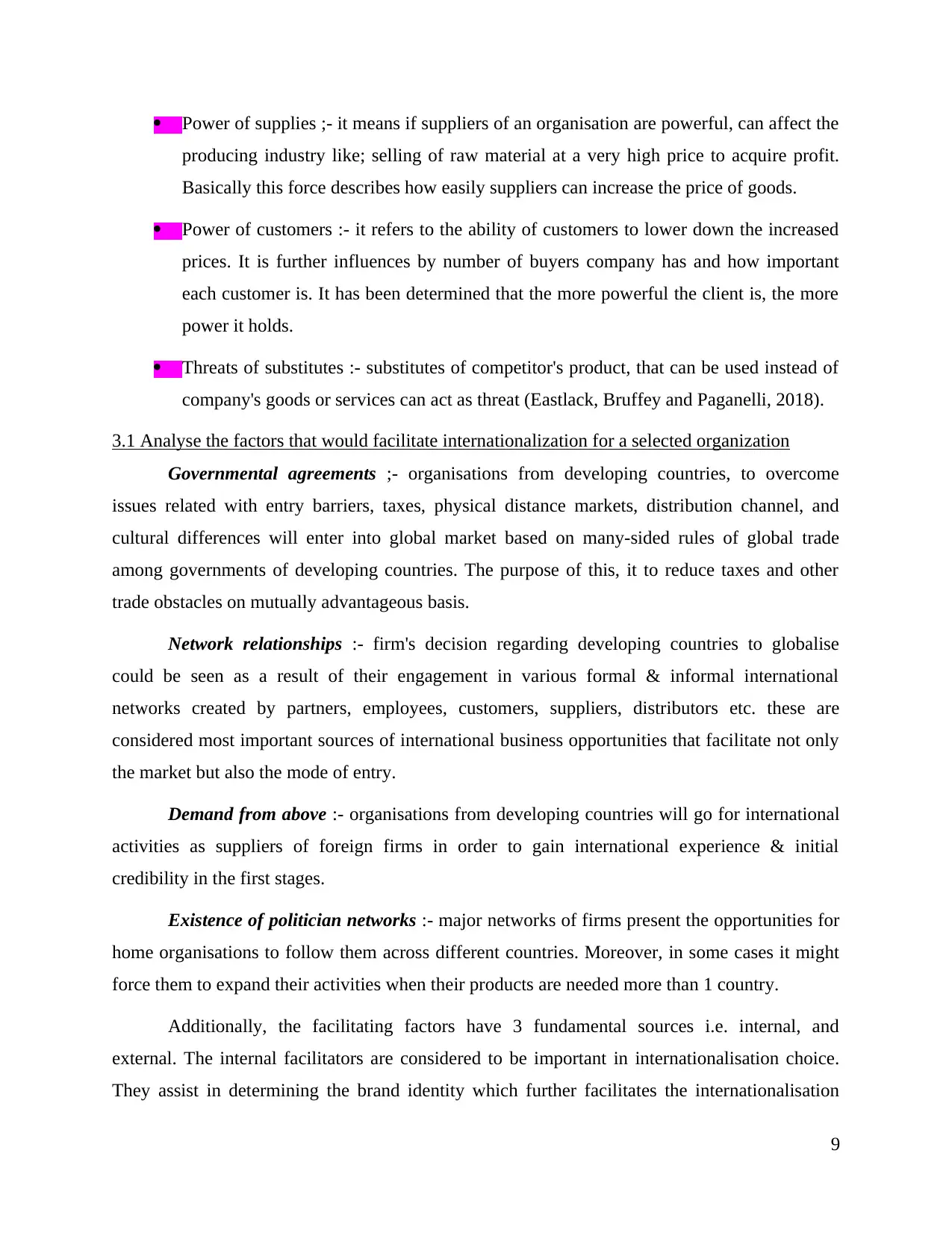
Power of supplies ;- it means if suppliers of an organisation are powerful, can affect the
producing industry like; selling of raw material at a very high price to acquire profit.
Basically this force describes how easily suppliers can increase the price of goods.
Power of customers :- it refers to the ability of customers to lower down the increased
prices. It is further influences by number of buyers company has and how important
each customer is. It has been determined that the more powerful the client is, the more
power it holds.
Threats of substitutes :- substitutes of competitor's product, that can be used instead of
company's goods or services can act as threat (Eastlack, Bruffey and Paganelli, 2018).
3.1 Analyse the factors that would facilitate internationalization for a selected organization
Governmental agreements ;- organisations from developing countries, to overcome
issues related with entry barriers, taxes, physical distance markets, distribution channel, and
cultural differences will enter into global market based on many-sided rules of global trade
among governments of developing countries. The purpose of this, it to reduce taxes and other
trade obstacles on mutually advantageous basis.
Network relationships :- firm's decision regarding developing countries to globalise
could be seen as a result of their engagement in various formal & informal international
networks created by partners, employees, customers, suppliers, distributors etc. these are
considered most important sources of international business opportunities that facilitate not only
the market but also the mode of entry.
Demand from above :- organisations from developing countries will go for international
activities as suppliers of foreign firms in order to gain international experience & initial
credibility in the first stages.
Existence of politician networks :- major networks of firms present the opportunities for
home organisations to follow them across different countries. Moreover, in some cases it might
force them to expand their activities when their products are needed more than 1 country.
Additionally, the facilitating factors have 3 fundamental sources i.e. internal, and
external. The internal facilitators are considered to be important in internationalisation choice.
They assist in determining the brand identity which further facilitates the internationalisation
9
producing industry like; selling of raw material at a very high price to acquire profit.
Basically this force describes how easily suppliers can increase the price of goods.
Power of customers :- it refers to the ability of customers to lower down the increased
prices. It is further influences by number of buyers company has and how important
each customer is. It has been determined that the more powerful the client is, the more
power it holds.
Threats of substitutes :- substitutes of competitor's product, that can be used instead of
company's goods or services can act as threat (Eastlack, Bruffey and Paganelli, 2018).
3.1 Analyse the factors that would facilitate internationalization for a selected organization
Governmental agreements ;- organisations from developing countries, to overcome
issues related with entry barriers, taxes, physical distance markets, distribution channel, and
cultural differences will enter into global market based on many-sided rules of global trade
among governments of developing countries. The purpose of this, it to reduce taxes and other
trade obstacles on mutually advantageous basis.
Network relationships :- firm's decision regarding developing countries to globalise
could be seen as a result of their engagement in various formal & informal international
networks created by partners, employees, customers, suppliers, distributors etc. these are
considered most important sources of international business opportunities that facilitate not only
the market but also the mode of entry.
Demand from above :- organisations from developing countries will go for international
activities as suppliers of foreign firms in order to gain international experience & initial
credibility in the first stages.
Existence of politician networks :- major networks of firms present the opportunities for
home organisations to follow them across different countries. Moreover, in some cases it might
force them to expand their activities when their products are needed more than 1 country.
Additionally, the facilitating factors have 3 fundamental sources i.e. internal, and
external. The internal facilitators are considered to be important in internationalisation choice.
They assist in determining the brand identity which further facilitates the internationalisation
9
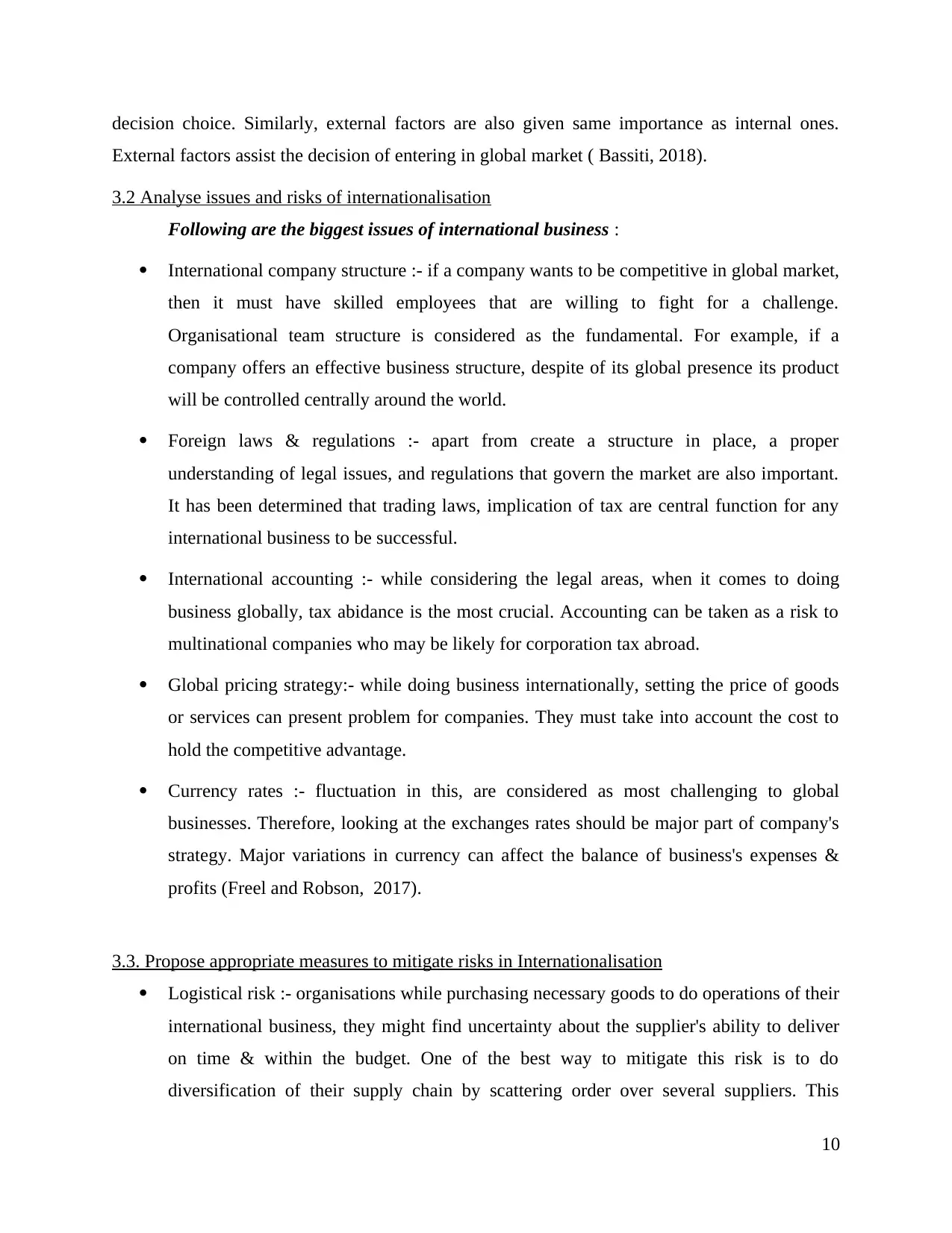
decision choice. Similarly, external factors are also given same importance as internal ones.
External factors assist the decision of entering in global market ( Bassiti, 2018).
3.2 Analyse issues and risks of internationalisation
Following are the biggest issues of international business :
International company structure :- if a company wants to be competitive in global market,
then it must have skilled employees that are willing to fight for a challenge.
Organisational team structure is considered as the fundamental. For example, if a
company offers an effective business structure, despite of its global presence its product
will be controlled centrally around the world.
Foreign laws & regulations :- apart from create a structure in place, a proper
understanding of legal issues, and regulations that govern the market are also important.
It has been determined that trading laws, implication of tax are central function for any
international business to be successful.
International accounting :- while considering the legal areas, when it comes to doing
business globally, tax abidance is the most crucial. Accounting can be taken as a risk to
multinational companies who may be likely for corporation tax abroad.
Global pricing strategy:- while doing business internationally, setting the price of goods
or services can present problem for companies. They must take into account the cost to
hold the competitive advantage.
Currency rates :- fluctuation in this, are considered as most challenging to global
businesses. Therefore, looking at the exchanges rates should be major part of company's
strategy. Major variations in currency can affect the balance of business's expenses &
profits (Freel and Robson, 2017).
3.3. Propose appropriate measures to mitigate risks in Internationalisation
Logistical risk :- organisations while purchasing necessary goods to do operations of their
international business, they might find uncertainty about the supplier's ability to deliver
on time & within the budget. One of the best way to mitigate this risk is to do
diversification of their supply chain by scattering order over several suppliers. This
10
External factors assist the decision of entering in global market ( Bassiti, 2018).
3.2 Analyse issues and risks of internationalisation
Following are the biggest issues of international business :
International company structure :- if a company wants to be competitive in global market,
then it must have skilled employees that are willing to fight for a challenge.
Organisational team structure is considered as the fundamental. For example, if a
company offers an effective business structure, despite of its global presence its product
will be controlled centrally around the world.
Foreign laws & regulations :- apart from create a structure in place, a proper
understanding of legal issues, and regulations that govern the market are also important.
It has been determined that trading laws, implication of tax are central function for any
international business to be successful.
International accounting :- while considering the legal areas, when it comes to doing
business globally, tax abidance is the most crucial. Accounting can be taken as a risk to
multinational companies who may be likely for corporation tax abroad.
Global pricing strategy:- while doing business internationally, setting the price of goods
or services can present problem for companies. They must take into account the cost to
hold the competitive advantage.
Currency rates :- fluctuation in this, are considered as most challenging to global
businesses. Therefore, looking at the exchanges rates should be major part of company's
strategy. Major variations in currency can affect the balance of business's expenses &
profits (Freel and Robson, 2017).
3.3. Propose appropriate measures to mitigate risks in Internationalisation
Logistical risk :- organisations while purchasing necessary goods to do operations of their
international business, they might find uncertainty about the supplier's ability to deliver
on time & within the budget. One of the best way to mitigate this risk is to do
diversification of their supply chain by scattering order over several suppliers. This
10
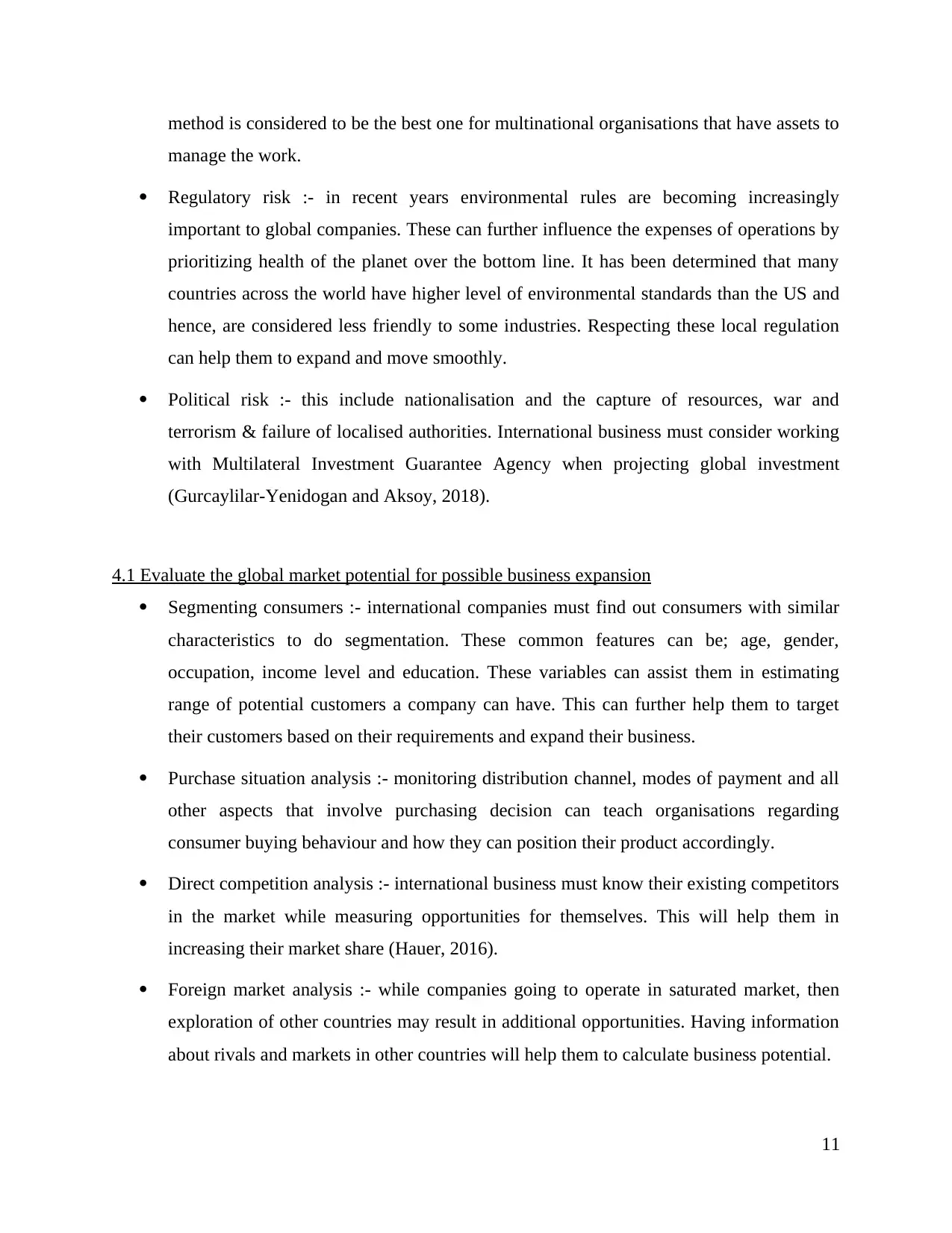
method is considered to be the best one for multinational organisations that have assets to
manage the work.
Regulatory risk :- in recent years environmental rules are becoming increasingly
important to global companies. These can further influence the expenses of operations by
prioritizing health of the planet over the bottom line. It has been determined that many
countries across the world have higher level of environmental standards than the US and
hence, are considered less friendly to some industries. Respecting these local regulation
can help them to expand and move smoothly.
Political risk :- this include nationalisation and the capture of resources, war and
terrorism & failure of localised authorities. International business must consider working
with Multilateral Investment Guarantee Agency when projecting global investment
(Gurcaylilar-Yenidogan and Aksoy, 2018).
4.1 Evaluate the global market potential for possible business expansion
Segmenting consumers :- international companies must find out consumers with similar
characteristics to do segmentation. These common features can be; age, gender,
occupation, income level and education. These variables can assist them in estimating
range of potential customers a company can have. This can further help them to target
their customers based on their requirements and expand their business.
Purchase situation analysis :- monitoring distribution channel, modes of payment and all
other aspects that involve purchasing decision can teach organisations regarding
consumer buying behaviour and how they can position their product accordingly.
Direct competition analysis :- international business must know their existing competitors
in the market while measuring opportunities for themselves. This will help them in
increasing their market share (Hauer, 2016).
Foreign market analysis :- while companies going to operate in saturated market, then
exploration of other countries may result in additional opportunities. Having information
about rivals and markets in other countries will help them to calculate business potential.
11
manage the work.
Regulatory risk :- in recent years environmental rules are becoming increasingly
important to global companies. These can further influence the expenses of operations by
prioritizing health of the planet over the bottom line. It has been determined that many
countries across the world have higher level of environmental standards than the US and
hence, are considered less friendly to some industries. Respecting these local regulation
can help them to expand and move smoothly.
Political risk :- this include nationalisation and the capture of resources, war and
terrorism & failure of localised authorities. International business must consider working
with Multilateral Investment Guarantee Agency when projecting global investment
(Gurcaylilar-Yenidogan and Aksoy, 2018).
4.1 Evaluate the global market potential for possible business expansion
Segmenting consumers :- international companies must find out consumers with similar
characteristics to do segmentation. These common features can be; age, gender,
occupation, income level and education. These variables can assist them in estimating
range of potential customers a company can have. This can further help them to target
their customers based on their requirements and expand their business.
Purchase situation analysis :- monitoring distribution channel, modes of payment and all
other aspects that involve purchasing decision can teach organisations regarding
consumer buying behaviour and how they can position their product accordingly.
Direct competition analysis :- international business must know their existing competitors
in the market while measuring opportunities for themselves. This will help them in
increasing their market share (Hauer, 2016).
Foreign market analysis :- while companies going to operate in saturated market, then
exploration of other countries may result in additional opportunities. Having information
about rivals and markets in other countries will help them to calculate business potential.
11
Secure Best Marks with AI Grader
Need help grading? Try our AI Grader for instant feedback on your assignments.
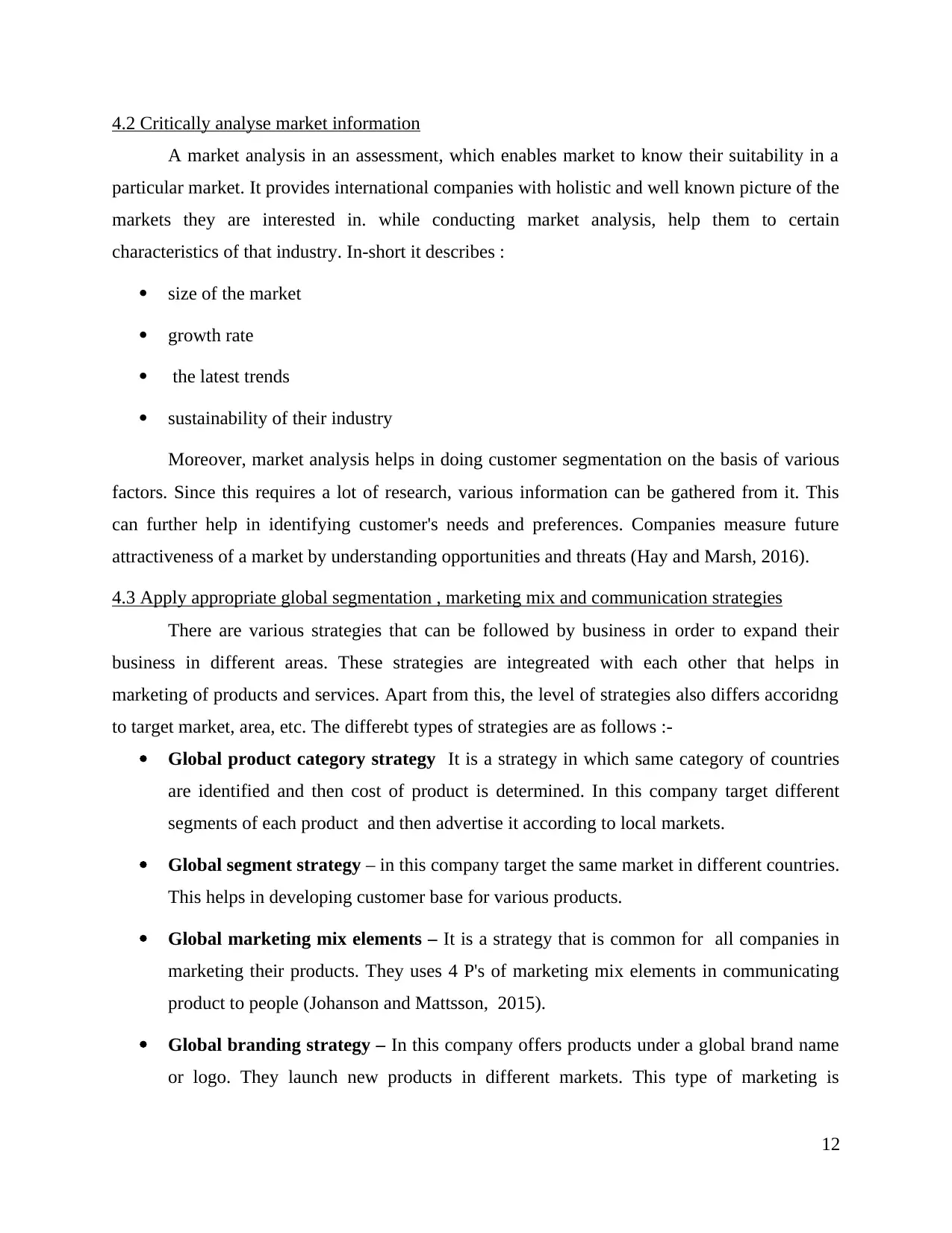
4.2 Critically analyse market information
A market analysis in an assessment, which enables market to know their suitability in a
particular market. It provides international companies with holistic and well known picture of the
markets they are interested in. while conducting market analysis, help them to certain
characteristics of that industry. In-short it describes :
size of the market
growth rate
the latest trends
sustainability of their industry
Moreover, market analysis helps in doing customer segmentation on the basis of various
factors. Since this requires a lot of research, various information can be gathered from it. This
can further help in identifying customer's needs and preferences. Companies measure future
attractiveness of a market by understanding opportunities and threats (Hay and Marsh, 2016).
4.3 Apply appropriate global segmentation , marketing mix and communication strategies
There are various strategies that can be followed by business in order to expand their
business in different areas. These strategies are integreated with each other that helps in
marketing of products and services. Apart from this, the level of strategies also differs accoridng
to target market, area, etc. The differebt types of strategies are as follows :-
Global product category strategy It is a strategy in which same category of countries
are identified and then cost of product is determined. In this company target different
segments of each product and then advertise it according to local markets.
Global segment strategy – in this company target the same market in different countries.
This helps in developing customer base for various products.
Global marketing mix elements – It is a strategy that is common for all companies in
marketing their products. They uses 4 P's of marketing mix elements in communicating
product to people (Johanson and Mattsson, 2015).
Global branding strategy – In this company offers products under a global brand name
or logo. They launch new products in different markets. This type of marketing is
12
A market analysis in an assessment, which enables market to know their suitability in a
particular market. It provides international companies with holistic and well known picture of the
markets they are interested in. while conducting market analysis, help them to certain
characteristics of that industry. In-short it describes :
size of the market
growth rate
the latest trends
sustainability of their industry
Moreover, market analysis helps in doing customer segmentation on the basis of various
factors. Since this requires a lot of research, various information can be gathered from it. This
can further help in identifying customer's needs and preferences. Companies measure future
attractiveness of a market by understanding opportunities and threats (Hay and Marsh, 2016).
4.3 Apply appropriate global segmentation , marketing mix and communication strategies
There are various strategies that can be followed by business in order to expand their
business in different areas. These strategies are integreated with each other that helps in
marketing of products and services. Apart from this, the level of strategies also differs accoridng
to target market, area, etc. The differebt types of strategies are as follows :-
Global product category strategy It is a strategy in which same category of countries
are identified and then cost of product is determined. In this company target different
segments of each product and then advertise it according to local markets.
Global segment strategy – in this company target the same market in different countries.
This helps in developing customer base for various products.
Global marketing mix elements – It is a strategy that is common for all companies in
marketing their products. They uses 4 P's of marketing mix elements in communicating
product to people (Johanson and Mattsson, 2015).
Global branding strategy – In this company offers products under a global brand name
or logo. They launch new products in different markets. This type of marketing is
12
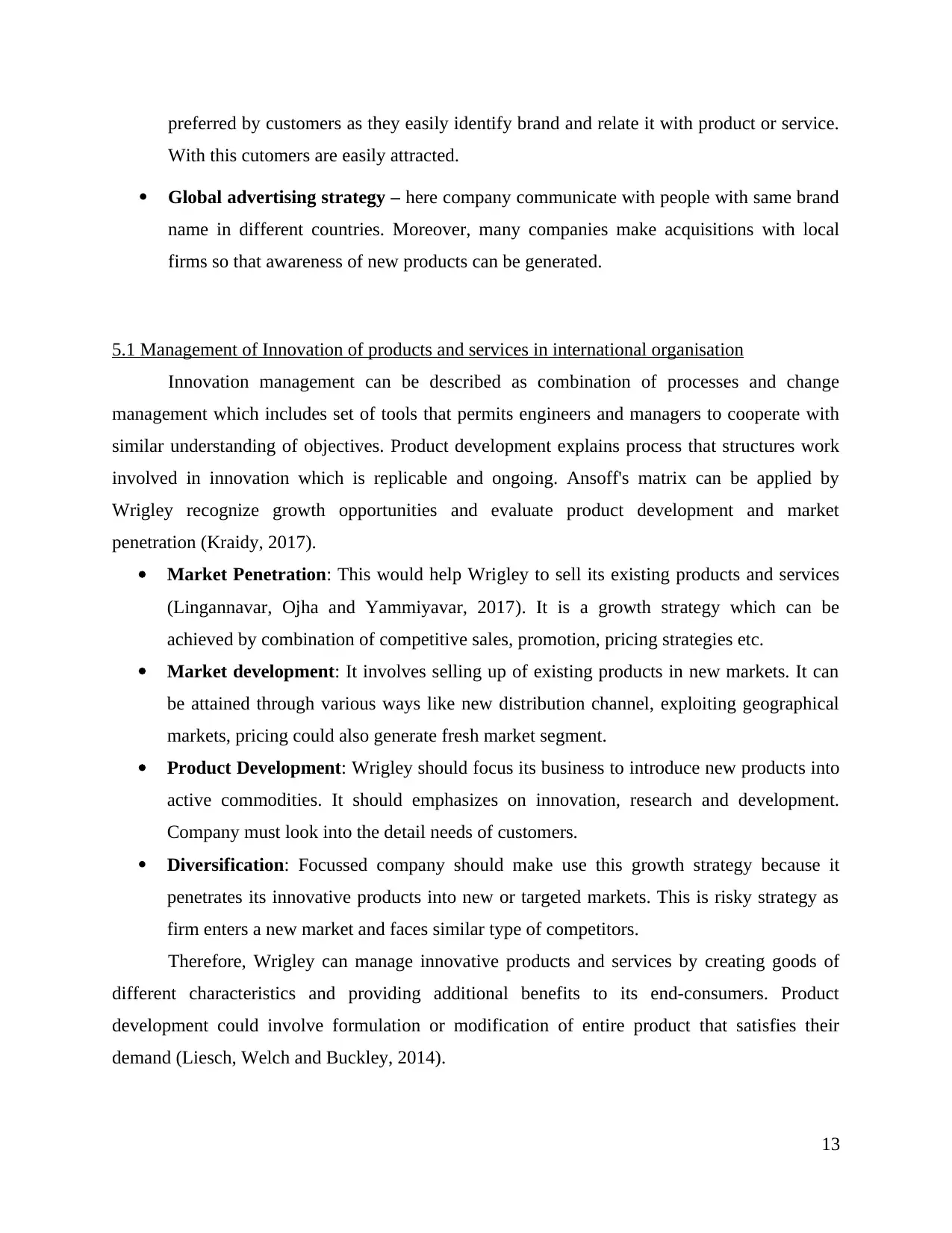
preferred by customers as they easily identify brand and relate it with product or service.
With this cutomers are easily attracted.
Global advertising strategy – here company communicate with people with same brand
name in different countries. Moreover, many companies make acquisitions with local
firms so that awareness of new products can be generated.
5.1 Management of Innovation of products and services in international organisation
Innovation management can be described as combination of processes and change
management which includes set of tools that permits engineers and managers to cooperate with
similar understanding of objectives. Product development explains process that structures work
involved in innovation which is replicable and ongoing. Ansoff's matrix can be applied by
Wrigley recognize growth opportunities and evaluate product development and market
penetration (Kraidy, 2017).
Market Penetration: This would help Wrigley to sell its existing products and services
(Lingannavar, Ojha and Yammiyavar, 2017). It is a growth strategy which can be
achieved by combination of competitive sales, promotion, pricing strategies etc.
Market development: It involves selling up of existing products in new markets. It can
be attained through various ways like new distribution channel, exploiting geographical
markets, pricing could also generate fresh market segment.
Product Development: Wrigley should focus its business to introduce new products into
active commodities. It should emphasizes on innovation, research and development.
Company must look into the detail needs of customers.
Diversification: Focussed company should make use this growth strategy because it
penetrates its innovative products into new or targeted markets. This is risky strategy as
firm enters a new market and faces similar type of competitors.
Therefore, Wrigley can manage innovative products and services by creating goods of
different characteristics and providing additional benefits to its end-consumers. Product
development could involve formulation or modification of entire product that satisfies their
demand (Liesch, Welch and Buckley, 2014).
13
With this cutomers are easily attracted.
Global advertising strategy – here company communicate with people with same brand
name in different countries. Moreover, many companies make acquisitions with local
firms so that awareness of new products can be generated.
5.1 Management of Innovation of products and services in international organisation
Innovation management can be described as combination of processes and change
management which includes set of tools that permits engineers and managers to cooperate with
similar understanding of objectives. Product development explains process that structures work
involved in innovation which is replicable and ongoing. Ansoff's matrix can be applied by
Wrigley recognize growth opportunities and evaluate product development and market
penetration (Kraidy, 2017).
Market Penetration: This would help Wrigley to sell its existing products and services
(Lingannavar, Ojha and Yammiyavar, 2017). It is a growth strategy which can be
achieved by combination of competitive sales, promotion, pricing strategies etc.
Market development: It involves selling up of existing products in new markets. It can
be attained through various ways like new distribution channel, exploiting geographical
markets, pricing could also generate fresh market segment.
Product Development: Wrigley should focus its business to introduce new products into
active commodities. It should emphasizes on innovation, research and development.
Company must look into the detail needs of customers.
Diversification: Focussed company should make use this growth strategy because it
penetrates its innovative products into new or targeted markets. This is risky strategy as
firm enters a new market and faces similar type of competitors.
Therefore, Wrigley can manage innovative products and services by creating goods of
different characteristics and providing additional benefits to its end-consumers. Product
development could involve formulation or modification of entire product that satisfies their
demand (Liesch, Welch and Buckley, 2014).
13
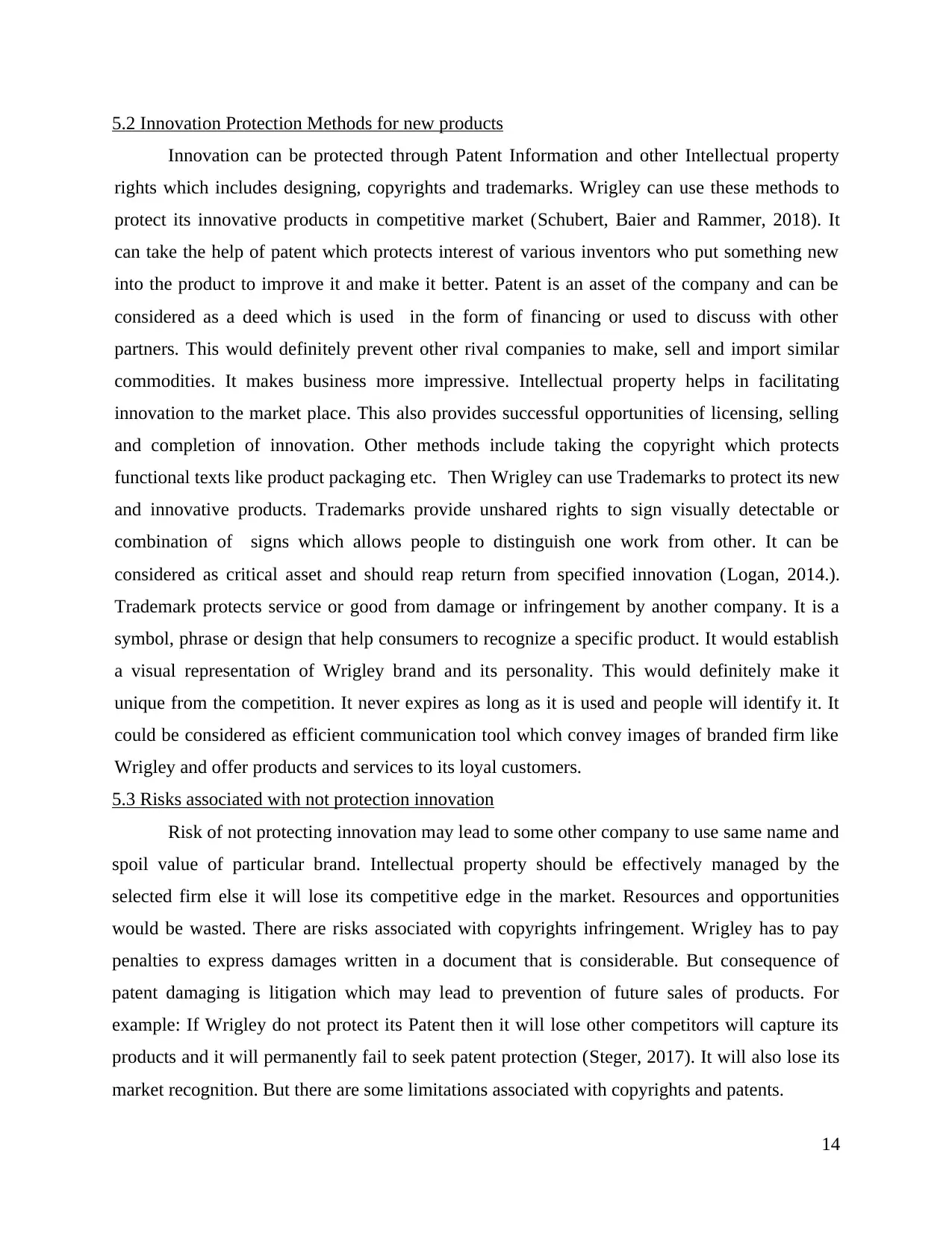
5.2 Innovation Protection Methods for new products
Innovation can be protected through Patent Information and other Intellectual property
rights which includes designing, copyrights and trademarks. Wrigley can use these methods to
protect its innovative products in competitive market (Schubert, Baier and Rammer, 2018). It
can take the help of patent which protects interest of various inventors who put something new
into the product to improve it and make it better. Patent is an asset of the company and can be
considered as a deed which is used in the form of financing or used to discuss with other
partners. This would definitely prevent other rival companies to make, sell and import similar
commodities. It makes business more impressive. Intellectual property helps in facilitating
innovation to the market place. This also provides successful opportunities of licensing, selling
and completion of innovation. Other methods include taking the copyright which protects
functional texts like product packaging etc. Then Wrigley can use Trademarks to protect its new
and innovative products. Trademarks provide unshared rights to sign visually detectable or
combination of signs which allows people to distinguish one work from other. It can be
considered as critical asset and should reap return from specified innovation (Logan, 2014.).
Trademark protects service or good from damage or infringement by another company. It is a
symbol, phrase or design that help consumers to recognize a specific product. It would establish
a visual representation of Wrigley brand and its personality. This would definitely make it
unique from the competition. It never expires as long as it is used and people will identify it. It
could be considered as efficient communication tool which convey images of branded firm like
Wrigley and offer products and services to its loyal customers.
5.3 Risks associated with not protection innovation
Risk of not protecting innovation may lead to some other company to use same name and
spoil value of particular brand. Intellectual property should be effectively managed by the
selected firm else it will lose its competitive edge in the market. Resources and opportunities
would be wasted. There are risks associated with copyrights infringement. Wrigley has to pay
penalties to express damages written in a document that is considerable. But consequence of
patent damaging is litigation which may lead to prevention of future sales of products. For
example: If Wrigley do not protect its Patent then it will lose other competitors will capture its
products and it will permanently fail to seek patent protection (Steger, 2017). It will also lose its
market recognition. But there are some limitations associated with copyrights and patents.
14
Innovation can be protected through Patent Information and other Intellectual property
rights which includes designing, copyrights and trademarks. Wrigley can use these methods to
protect its innovative products in competitive market (Schubert, Baier and Rammer, 2018). It
can take the help of patent which protects interest of various inventors who put something new
into the product to improve it and make it better. Patent is an asset of the company and can be
considered as a deed which is used in the form of financing or used to discuss with other
partners. This would definitely prevent other rival companies to make, sell and import similar
commodities. It makes business more impressive. Intellectual property helps in facilitating
innovation to the market place. This also provides successful opportunities of licensing, selling
and completion of innovation. Other methods include taking the copyright which protects
functional texts like product packaging etc. Then Wrigley can use Trademarks to protect its new
and innovative products. Trademarks provide unshared rights to sign visually detectable or
combination of signs which allows people to distinguish one work from other. It can be
considered as critical asset and should reap return from specified innovation (Logan, 2014.).
Trademark protects service or good from damage or infringement by another company. It is a
symbol, phrase or design that help consumers to recognize a specific product. It would establish
a visual representation of Wrigley brand and its personality. This would definitely make it
unique from the competition. It never expires as long as it is used and people will identify it. It
could be considered as efficient communication tool which convey images of branded firm like
Wrigley and offer products and services to its loyal customers.
5.3 Risks associated with not protection innovation
Risk of not protecting innovation may lead to some other company to use same name and
spoil value of particular brand. Intellectual property should be effectively managed by the
selected firm else it will lose its competitive edge in the market. Resources and opportunities
would be wasted. There are risks associated with copyrights infringement. Wrigley has to pay
penalties to express damages written in a document that is considerable. But consequence of
patent damaging is litigation which may lead to prevention of future sales of products. For
example: If Wrigley do not protect its Patent then it will lose other competitors will capture its
products and it will permanently fail to seek patent protection (Steger, 2017). It will also lose its
market recognition. But there are some limitations associated with copyrights and patents.
14
Paraphrase This Document
Need a fresh take? Get an instant paraphrase of this document with our AI Paraphraser

Patents are expensive and short term economic life is there as compared to Intellectual
Protection. Trademark has become genericide among public and have lost their value. They only
stand for branded products. These branded names are not allowed to make mistakes in real world
because they leave huge impact on public and thus their market value gets decreased. For
example: Wrigley produces any unusual product which do not satisfy customer then it will
consequently lose its value which will affect its cost in the future. Then, public won't like buying
furthermore goods of this company. Therefore, there are various risks related to protection of
innovation which Wrigley should consider (Steger, 2017).
CONCLUSION
The overall report concluded that, Market design plays a key role in promoting
innovations. According to the influence on the integration between countries on both the national
and international society, it can be described as a complex entity. Apart from this it stated that,
technological driver has given shape & set foundation for modern globalisation. Further it
concluded that, innovation management can be described as combination of processes and
change management which includes set of tools that permits engineers and managers to
cooperate with similar understanding of objectives. Also, in the report the Wrigley's new product
launch its Orbit Drops have been explained very well. The variety of consumer trends are
explained in context of the new product launch by the company and in what ways globalisation
has impacted it overall market. The relationship between consumer trends and their needs have
been explained, this has ensured that the company has produced products are per their needs and
developments. At last, a variety of developments are made and explained the consumer market in
launch of its new product range.
15
Protection. Trademark has become genericide among public and have lost their value. They only
stand for branded products. These branded names are not allowed to make mistakes in real world
because they leave huge impact on public and thus their market value gets decreased. For
example: Wrigley produces any unusual product which do not satisfy customer then it will
consequently lose its value which will affect its cost in the future. Then, public won't like buying
furthermore goods of this company. Therefore, there are various risks related to protection of
innovation which Wrigley should consider (Steger, 2017).
CONCLUSION
The overall report concluded that, Market design plays a key role in promoting
innovations. According to the influence on the integration between countries on both the national
and international society, it can be described as a complex entity. Apart from this it stated that,
technological driver has given shape & set foundation for modern globalisation. Further it
concluded that, innovation management can be described as combination of processes and
change management which includes set of tools that permits engineers and managers to
cooperate with similar understanding of objectives. Also, in the report the Wrigley's new product
launch its Orbit Drops have been explained very well. The variety of consumer trends are
explained in context of the new product launch by the company and in what ways globalisation
has impacted it overall market. The relationship between consumer trends and their needs have
been explained, this has ensured that the company has produced products are per their needs and
developments. At last, a variety of developments are made and explained the consumer market in
launch of its new product range.
15
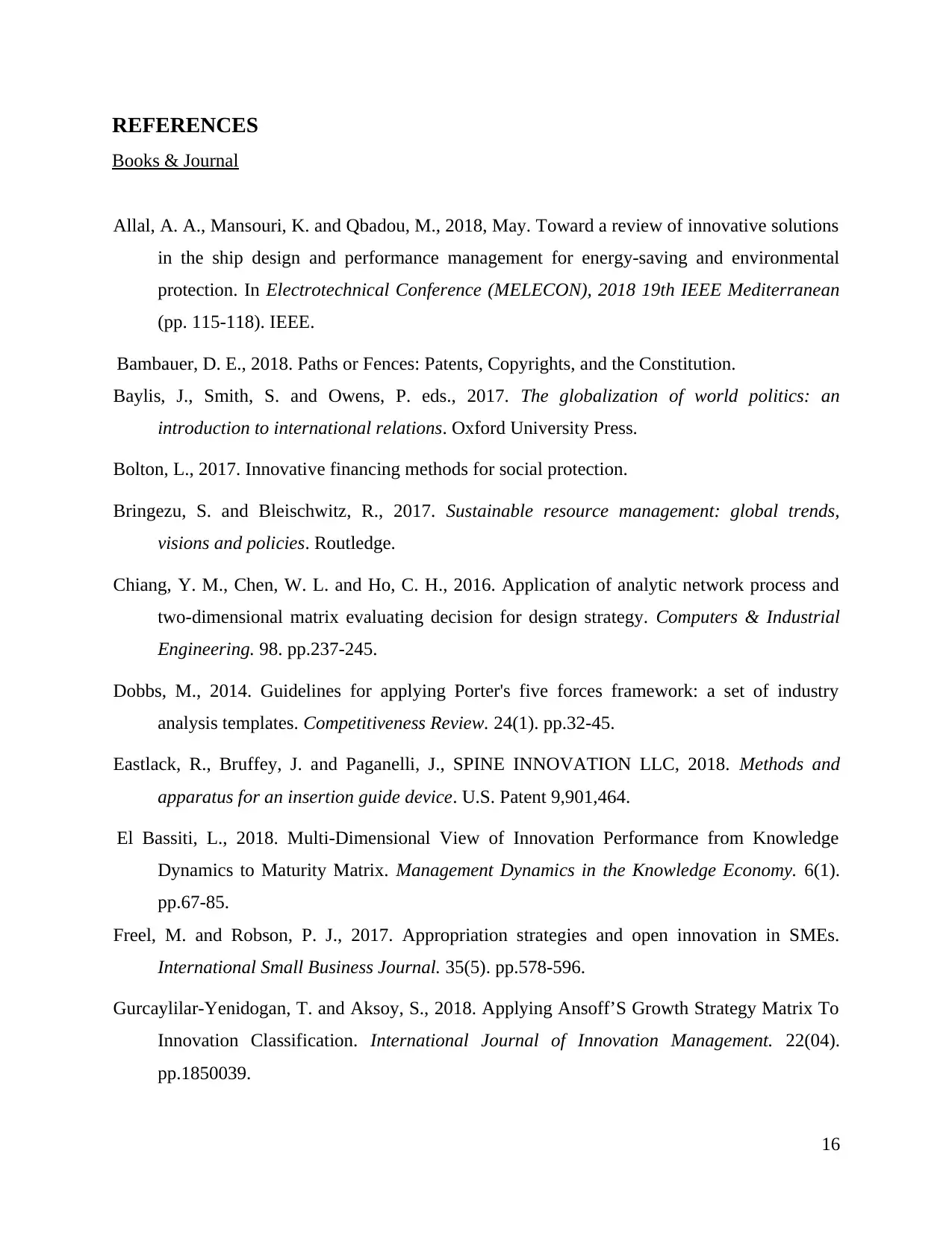
REFERENCES
Books & Journal
Allal, A. A., Mansouri, K. and Qbadou, M., 2018, May. Toward a review of innovative solutions
in the ship design and performance management for energy-saving and environmental
protection. In Electrotechnical Conference (MELECON), 2018 19th IEEE Mediterranean
(pp. 115-118). IEEE.
Bambauer, D. E., 2018. Paths or Fences: Patents, Copyrights, and the Constitution.
Baylis, J., Smith, S. and Owens, P. eds., 2017. The globalization of world politics: an
introduction to international relations. Oxford University Press.
Bolton, L., 2017. Innovative financing methods for social protection.
Bringezu, S. and Bleischwitz, R., 2017. Sustainable resource management: global trends,
visions and policies. Routledge.
Chiang, Y. M., Chen, W. L. and Ho, C. H., 2016. Application of analytic network process and
two-dimensional matrix evaluating decision for design strategy. Computers & Industrial
Engineering. 98. pp.237-245.
Dobbs, M., 2014. Guidelines for applying Porter's five forces framework: a set of industry
analysis templates. Competitiveness Review. 24(1). pp.32-45.
Eastlack, R., Bruffey, J. and Paganelli, J., SPINE INNOVATION LLC, 2018. Methods and
apparatus for an insertion guide device. U.S. Patent 9,901,464.
El Bassiti, L., 2018. Multi-Dimensional View of Innovation Performance from Knowledge
Dynamics to Maturity Matrix. Management Dynamics in the Knowledge Economy. 6(1).
pp.67-85.
Freel, M. and Robson, P. J., 2017. Appropriation strategies and open innovation in SMEs.
International Small Business Journal. 35(5). pp.578-596.
Gurcaylilar-Yenidogan, T. and Aksoy, S., 2018. Applying Ansoff’S Growth Strategy Matrix To
Innovation Classification. International Journal of Innovation Management. 22(04).
pp.1850039.
16
Books & Journal
Allal, A. A., Mansouri, K. and Qbadou, M., 2018, May. Toward a review of innovative solutions
in the ship design and performance management for energy-saving and environmental
protection. In Electrotechnical Conference (MELECON), 2018 19th IEEE Mediterranean
(pp. 115-118). IEEE.
Bambauer, D. E., 2018. Paths or Fences: Patents, Copyrights, and the Constitution.
Baylis, J., Smith, S. and Owens, P. eds., 2017. The globalization of world politics: an
introduction to international relations. Oxford University Press.
Bolton, L., 2017. Innovative financing methods for social protection.
Bringezu, S. and Bleischwitz, R., 2017. Sustainable resource management: global trends,
visions and policies. Routledge.
Chiang, Y. M., Chen, W. L. and Ho, C. H., 2016. Application of analytic network process and
two-dimensional matrix evaluating decision for design strategy. Computers & Industrial
Engineering. 98. pp.237-245.
Dobbs, M., 2014. Guidelines for applying Porter's five forces framework: a set of industry
analysis templates. Competitiveness Review. 24(1). pp.32-45.
Eastlack, R., Bruffey, J. and Paganelli, J., SPINE INNOVATION LLC, 2018. Methods and
apparatus for an insertion guide device. U.S. Patent 9,901,464.
El Bassiti, L., 2018. Multi-Dimensional View of Innovation Performance from Knowledge
Dynamics to Maturity Matrix. Management Dynamics in the Knowledge Economy. 6(1).
pp.67-85.
Freel, M. and Robson, P. J., 2017. Appropriation strategies and open innovation in SMEs.
International Small Business Journal. 35(5). pp.578-596.
Gurcaylilar-Yenidogan, T. and Aksoy, S., 2018. Applying Ansoff’S Growth Strategy Matrix To
Innovation Classification. International Journal of Innovation Management. 22(04).
pp.1850039.
16
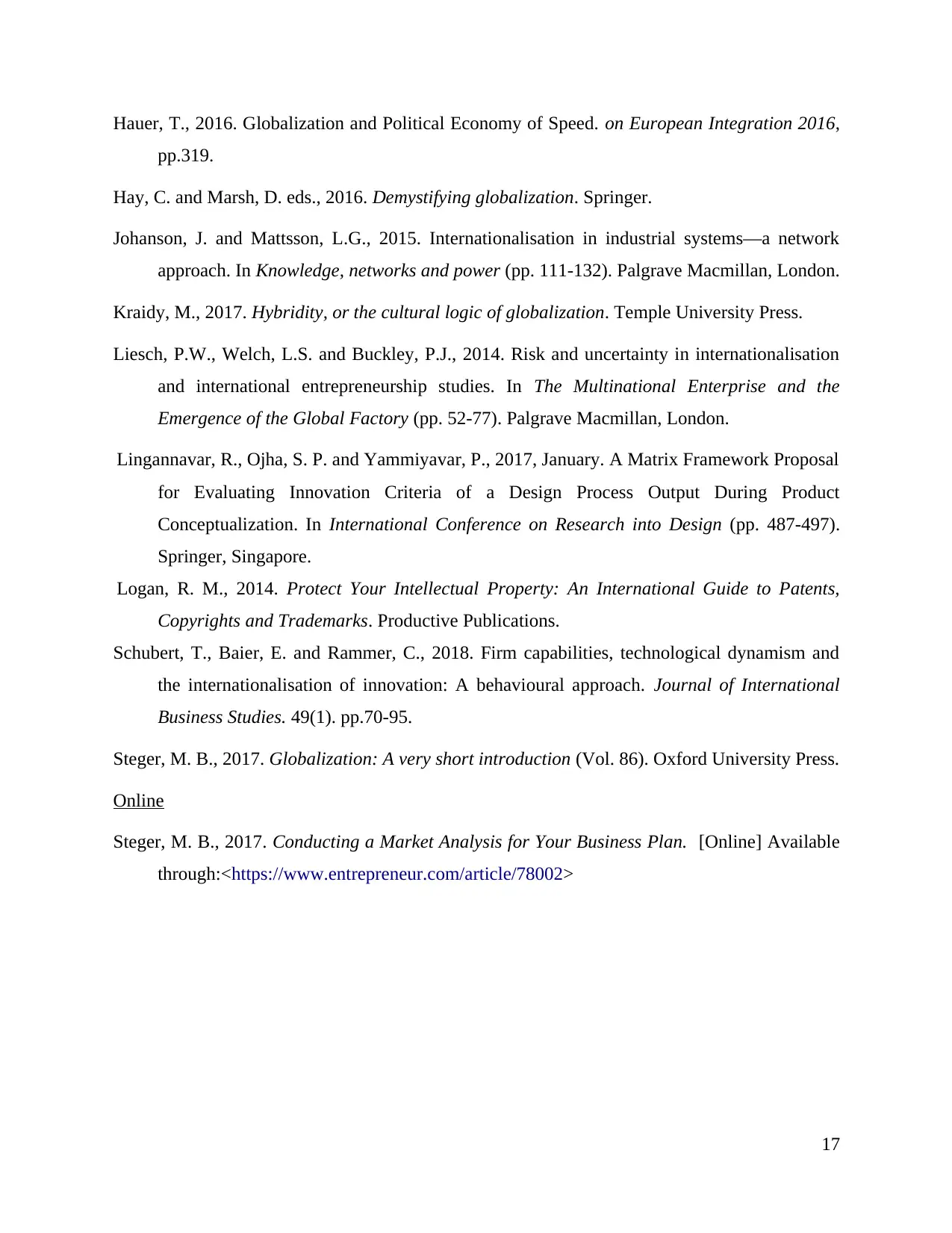
Hauer, T., 2016. Globalization and Political Economy of Speed. on European Integration 2016,
pp.319.
Hay, C. and Marsh, D. eds., 2016. Demystifying globalization. Springer.
Johanson, J. and Mattsson, L.G., 2015. Internationalisation in industrial systems—a network
approach. In Knowledge, networks and power (pp. 111-132). Palgrave Macmillan, London.
Kraidy, M., 2017. Hybridity, or the cultural logic of globalization. Temple University Press.
Liesch, P.W., Welch, L.S. and Buckley, P.J., 2014. Risk and uncertainty in internationalisation
and international entrepreneurship studies. In The Multinational Enterprise and the
Emergence of the Global Factory (pp. 52-77). Palgrave Macmillan, London.
Lingannavar, R., Ojha, S. P. and Yammiyavar, P., 2017, January. A Matrix Framework Proposal
for Evaluating Innovation Criteria of a Design Process Output During Product
Conceptualization. In International Conference on Research into Design (pp. 487-497).
Springer, Singapore.
Logan, R. M., 2014. Protect Your Intellectual Property: An International Guide to Patents,
Copyrights and Trademarks. Productive Publications.
Schubert, T., Baier, E. and Rammer, C., 2018. Firm capabilities, technological dynamism and
the internationalisation of innovation: A behavioural approach. Journal of International
Business Studies. 49(1). pp.70-95.
Steger, M. B., 2017. Globalization: A very short introduction (Vol. 86). Oxford University Press.
Online
Steger, M. B., 2017. Conducting a Market Analysis for Your Business Plan. [Online] Available
through:<https://www.entrepreneur.com/article/78002>
17
pp.319.
Hay, C. and Marsh, D. eds., 2016. Demystifying globalization. Springer.
Johanson, J. and Mattsson, L.G., 2015. Internationalisation in industrial systems—a network
approach. In Knowledge, networks and power (pp. 111-132). Palgrave Macmillan, London.
Kraidy, M., 2017. Hybridity, or the cultural logic of globalization. Temple University Press.
Liesch, P.W., Welch, L.S. and Buckley, P.J., 2014. Risk and uncertainty in internationalisation
and international entrepreneurship studies. In The Multinational Enterprise and the
Emergence of the Global Factory (pp. 52-77). Palgrave Macmillan, London.
Lingannavar, R., Ojha, S. P. and Yammiyavar, P., 2017, January. A Matrix Framework Proposal
for Evaluating Innovation Criteria of a Design Process Output During Product
Conceptualization. In International Conference on Research into Design (pp. 487-497).
Springer, Singapore.
Logan, R. M., 2014. Protect Your Intellectual Property: An International Guide to Patents,
Copyrights and Trademarks. Productive Publications.
Schubert, T., Baier, E. and Rammer, C., 2018. Firm capabilities, technological dynamism and
the internationalisation of innovation: A behavioural approach. Journal of International
Business Studies. 49(1). pp.70-95.
Steger, M. B., 2017. Globalization: A very short introduction (Vol. 86). Oxford University Press.
Online
Steger, M. B., 2017. Conducting a Market Analysis for Your Business Plan. [Online] Available
through:<https://www.entrepreneur.com/article/78002>
17
Secure Best Marks with AI Grader
Need help grading? Try our AI Grader for instant feedback on your assignments.

18
1 out of 20
Related Documents
Your All-in-One AI-Powered Toolkit for Academic Success.
+13062052269
info@desklib.com
Available 24*7 on WhatsApp / Email
![[object Object]](/_next/static/media/star-bottom.7253800d.svg)
Unlock your academic potential
© 2024 | Zucol Services PVT LTD | All rights reserved.


